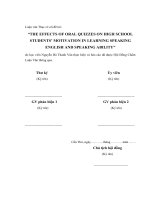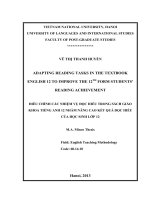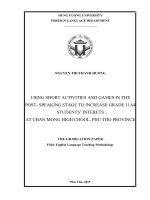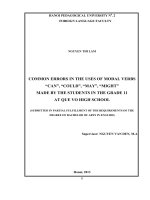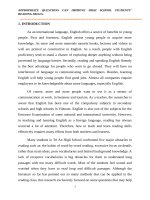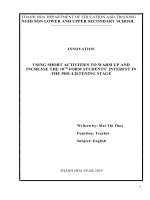USING MIND MAPS IN THE PRE WRITING STAGE TO IMPROVE HIGH SCHOOL STUDENTS’ WRITING SKILLS
Bạn đang xem bản rút gọn của tài liệu. Xem và tải ngay bản đầy đủ của tài liệu tại đây (374.6 KB, 90 trang )
1
MINISTRY OF EDUCATION AND TRAINING
VINH UNIVERSITY
TRAN THI THU HIEN
USING MIND MAPS IN THE PRE-WRITING STAGE TO
IMPROVE HIGH SCHOOL STUDENTS’ WRITING SKILLS
Major: Teaching English to Speakers of Other Language (TESOL)
Code: 60.14.01.11
MASTER’S THESIS IN EDUCATION
SUPERVISOR:
Assoc.Prof.Dr. NGƠ ĐÌNH PHƯƠNG
Nghệ An, 2017
i
Acknowledgement
I would like to express my deepest appreciation and gratitude to Associate
Professor Doctor Ngo Dinh Phuong, my supervisor for his continual
understanding, support, interest and trust in my success for managing this thesis
during the study. He always motivated me with his invaluable comments,
organized and hard working personality.
Without his encouragement and
inspiration this study would never come true.
My special thanks go to all of the 6th graders and English teachers at Ha
Huy Tap Secondary school who are always willing to take part in the study
seriously and the contribution to the survey truthfully in order to results in the
answers and findings for this research.
Finally, I would like to extend my greatest gratitude to my colleague and
my family who always encouraged me to attend this program and their continual
support, patience, and trust in me so that I could complete this thesis.
Abstract
This research is implemented to investigate the attitudes of the 6 th graders
and teachers towards a new learning activity in innovated text book Tiếng Anh 6
– project work activity and the factors motive students in order to find out its
ii
effects on students’ motivation in English learning. Data used in this study were
collected through Likert scale questionnaires and students’ interview. Data
collected with the questionnaire was analyzed by the use of descriptive statistics.
For this purpose, SPSS (Statistical Programming for Social Sciences) software
was used to analyze the questionnaire. Data collected through interviews were
analyzed qualitatively.
The results of the students’ questionnaires revealed that most the 6 th
graders appear to welcome this new fresh activity in their English classroom
with positive responses such as project work activity enhance their creativity,
interesting learning atmosphere, their brave in speaking, etc. The results from
the questionnaires also uncover the factors which motivate students in English
learning like cooperation, learning autonomy and others.
With the aim of finding the effects of project work activity, the
combination of teachers and students’ view towards the activity was employed
and showed key findings as vocabulary improvement, team working and social
skills.
Finally, the research suggests some pedagogical implications of the effects
of project work activity on students’ motivation in English acquisition.
Table of Contents
Acknowledgement..........................................................................................................i
Abstract........................................................................................................................... i
Table of Contents...........................................................................................................ii
iii
List of table................................................................................................................... iv
List of Abbreviation......................................................................................................vi
Introduction.................................................................................................................... 1
Chapter 1: Introduction..................................................................................................2
1.1. Rationale.................................................................................................................2
1.2. Aims of the study....................................................................................................4
1.3. Research question...................................................................................................4
1.4. The scope of the study............................................................................................4
1.5. The design of the study...........................................................................................5
Chapter 2: Literature review..........................................................................................6
2.1. PROJECT WORK...................................................................................................6
2.1.1. An overview of Project Based Learning.................................................................................................. 6
2.1.2. The use of project work in the teaching of English as a foreign language................................................7
2.1.2.1. Definition of project work............................................................................................................... 7
2.1.2.2. The features of project work............................................................................................................ 8
2.1.2.3. The benefits of project work in teaching English as a foreign language..........................................10
2.1.3. The implementation of Project Work in textbook English 6..................................................................12
2.1.3.1. The objectives of Project Work in textbook English 6....................................................................12
2.1.3.2. The description of Project Work activity in textbook English 6......................................................13
2.2. MOTIVATION IN LANGUAGE LEARNING.....................................................15
2.2.1. Definition of motivation....................................................................................................................... 15
2.2.2. Motivation in foreign language learning............................................................................................... 15
2.2.3. Classification of motivation.................................................................................................................. 20
2.2.3.1. Gardner’s Socio-educational Model................................................................................................... 20
a. Integrative motivation................................................................................................................................ 22
b. Instrumental motivation............................................................................................................................. 23
c. Integrative motivation vs. instrumental motivation.....................................................................................23
2.2.3.2. Self-determination motivation........................................................................................................... 25
a. Intrinsic motivation................................................................................................................................ 26
b. Extrinsic motivation............................................................................................................................... 27
c. Intrinsic motivation versus extrinsic motivation......................................................................................28
2.2.4. Factors affecting motivation in L2 acquisition...................................................................................... 29
Chapter 3: Research methodology...............................................................................31
3.1. Study design............................................................................................................................................ 31
3.2. Participants of the study.......................................................................................................................... 31
3.3. Instruments of data collection.................................................................................................................. 31
3.3.1. Questionnaires.................................................................................................................................. 31
3.3.1.1. The steps of designing the questionnaire........................................................................................ 32
3.3.1.2. Description of the questionnaire.................................................................................................... 33
3.3.1.3. Scale reliability.............................................................................................................................. 34
3.3.2. Interview.......................................................................................................................................... 34
3.4. Statistical analysis procedures................................................................................................................. 35
3.4.1. Questionnaire data............................................................................................................................ 35
3.4.2. Interview data................................................................................................................................... 36
iv
Chapter 4: Results and discussion................................................................................36
4.1. Results.................................................................................................................................................... 37
4.1.1. Students’ attitude towards project work............................................................................................ 38
4.1.2. Motivating factors of PW................................................................................................................. 41
4.1.2.1. Factors relating to the topics of PW............................................................................................... 41
4.1.2.2. Factors relating to students’ cooperation........................................................................................42
4.1.2.3. Factors relating to students’ autonomy........................................................................................... 44
4.1.2.4. Factors relating to teacher’s facilitation.......................................................................................... 45
4.1.2.5. Factors relating to assessments...................................................................................................... 45
4.1.2.6. Factors relating to task value......................................................................................................... 46
4.1.3. Effects of project work on students’ motivation................................................................................47
4.1.4. Teachers’ view to the effects of project work on their students’ motivation.......................................49
4.2. Discussion of main findings.................................................................................................................... 52
4.2.1. Students’ attitude towards project work............................................................................................ 52
4.2.2. Motivating factors of project work.................................................................................................... 53
4.2.3. Effects of project work on students’ motivation................................................................................54
4.3. Pedagogical implications......................................................................................................................... 56
Chapter 5: Conclusion..................................................................................................58
5.1. Summary...............................................................................................................58
5.2. Limitation of the study..........................................................................................59
5.3. Suggestions for further study................................................................................59
References.................................................................................................................... 60
APPENDICES.............................................................................................................69
List of table
Table 3.1. Reliability coefficient in students’ questionnaire.........................................34
Table 3.2. Reliability coefficient in teachers’ questionnaire.........................................34
Table 4.1a. Students’ attitude to the project work........................................................38
Table 4.1b. Students’ opinion on types of PW.............................................................40
Table 4.2. Factors relating to the topics of PW............................................................42
Table 4.3. Factors relating to students’ cooperation.....................................................42
Table 4.4. Factors relating to students’ autonomy........................................................44
v
Table 4.5. Factors relating to teacher’s facilitation.......................................................45
Table 4.6. Factors relating to assessments....................................................................45
Table 4.7. Factors relating to task value.......................................................................46
Table 4.8. Students’ opinions on the effects of PW on their motivation.......................47
Table 4.9. Teachers’ view on the effects of PW on their students’ motivation..............50
vi
List of Abbreviation
PBL:
Project-based learning.
PW:
Project work.
SLA:
Second language acquisition.
ESL/ EFL: English as a second language/ English as a foreign language.
SPSS:
Statistical Package for the Social Sciences.
1
Introduction
In the decade of educational reform and innovation recently, it is
indisputable that approach, methodologies and techniques play as a key role in
teaching and learning improvement.
There have been numerous studies carried out onto the effectiveness of
approach, methodologies and techniques applied to enhance the quality of
English language acquisition. The project based learning approach offers to be
one of the most effective learning tools to improve students motivation and
interest in learning English. In an attempt to investigate the effects of project
based learning on 6th grade students’ motivation at Ha Huy Tap Secondary
school, the study concentrates on the theoretical background of project based
learning approach, students motivation in learning English; identification of the
effects of project work activity on students’ motivation in their English class as
well as suggestions for teaching and learning enhancement.
2
Chapter 1: Introduction
1.1. Rationale
It is undeniable that English is important in order to be able to integrate
and globalize all over the world. English is the language that most people in
different countries use to connect with others. For that reason, learning English
can be considered the key to successfully communicate globally.
In the industrialization and integration era, there has been a need of
changing in ways of teaching as well as the practical application in education.
Students nowadays are likely to immerse their lessons with practice and
practical experience rather than theory and knowledge that they just learn in
lessons. They are interested in dealing with real subject matter by working on
the real problems. Project based learning has been considered as an innovative
approach into modern teaching and learning.
According to the definitions found in Project-Based Learning (PBL)
handbook for teacher (John W. Thomas 2000), project based learning is a model
for classroom activity that shift away from the usual classrooms practices of
short, isolated, teacher-centered lessons. PBL learning activities are long-term,
interdisciplinary, student-centred, and integrated with real-world issues and
practices. It is a method that fosters abstract, intellectual tasks to explore
complex issues. It promotes understanding, which is true knowledge. Thus, the
role of Project based learning is truly indisputable. There have been more
common educators and educational affairs applying this approach into teaching
such as PBL in Maths, Technology, Geography, etc.
In 2008, big changes have been made in foreign language curriculum in
Vietnam. Project based learning has been implemented in the innovating
textbooks launched by national foreign languages project 2020 especially in
English textbooks. The aim of this change was to provide the students an
3
environment in which they can reach their own conclusions instead of just
lecturing them. A project work was added in a lesson in each teaching unit in
textbooks “Tiếng Anh 6”. Project work is a learning experience which aims to
provide students with the opportunity to synthesise knowledge from various
areas of learning, and critically and creatively apply it to real life situations. This
process, which enhances students’ knowledge and enables them to acquire skills
like collaboration, communication and independent learning, prepares them for
lifelong learning and the challenges ahead. Project work is the preparation and
presentation of a project, either by an individual or (more usually) a group. A
typical project might be producing a magazine or website out of individually
written articles (Scoot; 2006: 183). According to the authors in teacher’s book
“Tiếng Anh 6”, the project helps students to improve their ability to work by
themselves or a team, and extend their imagination in a field related to the unit
project. Therefore, the role of applying PBL into teaching and learning is urgent
and important.
The application of Project based learning into teaching and learning has
been considered as valuable and interesting points in the educational innovation.
The replacement of English textbook and application of grade 6 New
English textbook in the year of 2012 showed positive points in the field. The
Project activity applied into teaching has been considered as a great deal of
improvement in the Project.
As an English teacher in an English center in Vinh city, I have worked
quite closely with the new textbook “Tiếng Anh 6”. I have found that project
activity could benefit students in enhancing their English competence as well as
their motivation in learning. For my 6 th grade students, project work is really a
new task and they seem to be eager to participate in the activity. However, I
would like to gain a deeper insight into what students’ opinions on this activity
4
and how this activity helps promote their motivation. Therefore, I decided to
carry out an investigation into the project work in textbook “Tiếng Anh 6”to
identify the effects of this activity on 6th grade students’ motivation.
1.2. Aims of the study
This study was carried out with the following aims:
- To investigate the attitudes of 6 th grade students at Ha Huy Tap
secondary school to project work in their English class.
- To identify which factors of project work in the English textbook Tiếng
Anh 6 motivate 6th graders.
- To identify the effects of project work on 6 th graders’ motivation in their
English lessons.
1.3. Research question
In order to achieve the above aims, the study seeks the answers for the
following research questions:
1. What are the attitudes of 6th grade students at Ha Huy Tap secondary
school to project work in their English class?
2. What factors of project work in English textbook Tiếng Anh 6
motivate students?
3. What are the effects of project work on 6 th graders’ motivation in their
English lessons?
1.4. The scope of the study
The study only focuses on the effects of project work in the English
textbook Tiếng Anh 6 on motivating 6th graders at Ha Huy Tap secondary school
in order to find out suitable ways to make full use of project works for 6 th
graders in their English lessons.
5
1.5. The design of the study
The study is divided into 3 parts:
Chapter 1: Introduction presents the rationale, aims, research questions,
scope of the study and its design.
Chapter 2: Literature Review presents the theoretical background of
project work and motivation.
Chapter 3: Research methodology introduces participants, method and
procedure of data collection.
Chapter 4: Data discussion and findings. This chapter includes the
presentation of data analysis and discussion, and the presentation of main
findings
Chapter 5: Conclusion. This part summarizes the main ideas of the study,
present implication, limitation of the study and suggests further study.
6
Chapter 2: Literature review
This chapter presents relevant literature which helps to form the
theoretical framework for the study. It includes an overview of project based
learning, the use of project work in the teaching of English as a foreign language
as well as the benefits of project work in teaching English as a foreign language
and theoretical background relating to motivation in language learning.
2.1. PROJECT WORK
2.1.1. An overview of Project Based Learning
The switch from teacher-centred to learner-centred in language learning
has resulted to the emerge of many experiential approaches which ‘support
‘deeper learning’ through active exploration of real world problems and
challenges’ (Pellegrino & Hilton, 2012; Peterson, 2012). Among these is Project
Based Learning which is tracked to be first introduced by William Heard
Kilpatrick in the form of ‘project method’ (Peterson, 2012). Since then, experts
in the field of teaching methodology have proposed many definitions of Project
Based Learning. It is defined as ‘ a systematic teaching method that engages
students in learning knowledge and skills through an extended inquiry process
structured around complex, authentic questions and carefully designed products
and tasks’ ( Introduction to Project based learning). Similarly, Phyllis C.
Blumenfeld et al. (1991) clarifies that ‘Project based learning is a
comprehensive perspective focused on teaching by engaging students in
investigations’. According to these authors, within the framework of Project
Based Learning, students ‘pursue solutions to nontrivial problems by asking and
refining questions, debating ideas, making predictions, designing plans and/or
experiments,
collecting
and
analyzing
data,
drawing
conclusions,
communicating their ideas and findings to others, asking new questions, and
creating artifacts’. Project Based Learning (PBL) is an instructional approach
7
that contextualizes learning by presenting learners with problems to solve or
products to develop (Moss & Van Duzer, 1998) or simply put as ‘a model that
organizes learning around projects’ (Thomas, 2000). With PBL, learning is
happening when students are encouraged to explore real- world problems, issues
and challenges. With the ultimate aim of fostering students’ learning abilities
through contextualizing learning by requiring them to independently offer their
solutions to problems posed and/or create artifacts, Project Based Learning
(PBL) puts focus on student – centeredness.
2.1.2. The use of project work in the teaching of English as a foreign
language.
2.1.2.1. Definition of project work
Project-based learning has become prominent in the current context of
education which faces many challenges of the 21st century. Project-based
learning is widely used in ESL/ EFL curriculum. It is an instructional strategy
which ‘involves study/research of a topic in depth where students’ ideas,
questions, predictions and interests form the experiences lived and the
works/activities undertaken.’ (Filippatou D. & Kaldi S., 2010). In project-based
learning, students learn new knowledge through doing projects.
Project work is a learning experience which aims to provide students with
opportunities to synthesize what they have learnt and apply it to real life. Diana
Fried-Booth (1997) notes that project work is a method which involves students
in an authentic learning experience with language used for genuine
communication purpose. It is student-centered and its results are an end-product.
Legutke and Thomas (1993:160) define project work as ‘a theme and
task-centred mode of teaching and learning which results from a joint process of
negotiation between all participants. It allows for a wide scope of selfdetermined action for both the individual and the small group of learners within
8
a general frame work of a plan which defines goals and procedures. Project
learning realizes a dynamic balance between a process and a product orientation.
Finally, it is experimental and holistic because it bridges the gap dualism
between body and mind, theory and practice’.
Project work is viewed by most of its advocates ‘not as a replacement for
other teaching methods’ but rather as ‘an approach to learning which
complements mainstream methods and which can be used with almost levels,
ages, and abilities of students (Haines 1989:1).
2.1.2.2. The features of project work.
To clarify the concept ‘project’ used in Project-based learning, many
features are proposed by authors in the field.
Mergendoller and Michealson (1999) described projects within projectbased learning as ‘ based on challenging questions and making students having
central role in design, problem-solving, decision making processes so giving
students the opportunity to work relatively autonomously.’ Sharing the same
view, Filipatou & Kaldi (2010) states that projects in Project-based learning has
‘researching questions which have been raised by students or/and in
collaboration with the class teacher and could be further refined during the
course of the study’. Thomas (2000) points out that projects have five criteria
which are centrality, driving question, constructive investigation, autonomy, and
realism.
1. PBL projects are central, not peripheral to the curriculum.
2. PBL projects are focused on questions or problems that ‘drive’
students to encounter (and struggle with) the central concepts and principles of a
discipline.
3. Projects involve students in a constructive investigation.
4. Projects are student-driven to some significant degree.
9
5. Projects are realistic, not school-like.
According to Stoller (1997), project work is particularly effective in
language learning because it represents a natural extension of what is already
taking place in class. He summarized the sharing ideas of authors in the field
about the characteristics of project work as follow:
1. Project work focuses on content learning rather than on specific
language targets. Real- world subject matter and topics of interest to students
can become central to projects.
2. Project work is students centered, though the teacher plays a major
role in offering support and guidance through the process.
3. Project work is cooperative rather than competitive. Students can work
on their own, in small groups, or as a class to complete a project, sharing
resources, and expertise along the way.
4. Project work leads to the authentic integration of skills and processing
of information from varied sources, mirroring real-life tasks.
5. Project work culminates in an end product that can be shared with
others, giving the project a real purpose. The value of project, however, lies not
just in the final product but in the process of working towards the end point.
Thus, project work has both a process and product orientation, and provides
students with opportunities to focus on fluency and accuracy at different projectwork stage.
6. Project work is potentially motivating, stimulating, empowering, and
challenging. It usually results in building student confidence, self-esteem, and
autonomy as well as improving students’ language skills, content learning, and
cognitive abilities.
10
2.1.2.3. The benefits of project work in teaching English as a foreign
language.
It is widely agreed that project based learning is beneficial to the teaching
of English as a foreign language in the world in general and in Vietnam in
particularly.
According to Fried-Booth (2002), the process leading to the end-product
of project work provides opportunities for students to develop their confidence
and independence. Also, students demonstrate increased self-esteem, and
positive attitudes towards learning (Stoller, 2006:27). Sharing the same view,
Filippatou & Kaldi (2010:25) point out that while students work in groups, they
will also learn independently through self-reflection and evaluation of their own
processes. Pupils gain benefits through PBL in academic performance,
motivation, cooperative learning, social acceptance, and engagement in the
learning process.
Another benefit of project work in English class is that ‘working in the
groups, which project-based learning was employed made the students learn the
responsibility, provided them with motivation to learn, and enabled them to
acquire knowledge by receiving different ideas and understanding the others
point of view in the lesson’ ( Bas,2010:9). This idea is also noted by Lee (2002),
Brophy (2004), Larsen - Freeman (2000:149). Lee stated that students have
enhanced motivation, engagement and enjoyment. Whereas, Brophy notices that
from a motivational perspective, projects being authentic tasks, are more
meaningful to students, increase interest, motivation to participate, and can
promote learning. And Larsen-Freeman accepts that enjoyment and motivation
also stem from the fact that classroom language is not predetermined, but
depends on the nature of the project. Projects lend themselves to students’
working and learning collaboratively. Students are highly motivated when they
11
have frequent opportunities to talk over ideas with their peers. According to
Yamamoto & Kimura (2013), almost students were satisfied with their projects.
This may mean that projects could give them motivation to engage in their
learning. Projects can be designed to enhance most students’ interest and value,
including variety, challenge, choice, cooperation, and finding answers for real
questions. Westwood (2006) points out that projects promote meaningful
learning, connecting new learning to students’ past experience and prior
knowledge, they increase self-direction and motivation.
Moreover, project based learning is reported to help improve language
skills (Levine, 2004). Projects create chance for students to engage in purposeful
communication to complete authentic activities- tasks with real world relevance
and utility. Hence, they have opportunities to use language in a relatively natural
context and participate in meaningful activities which require authentic language
use. Fragoulis (2009) reports that most learners’ willingness to participate in
learning activities increased. They showed an improvement in all four language
skills especially their speaking and listening skills.
As discussed by Coleman (1992), projects also help increase students’
social, cooperative skills and group cohesiveness. Adopting projects in the
classroom also helps foster relationship among group members. Project based
learning enhances collaboration among learners and other community members
as well. Thus, project based learning provides learners with opportunities to
learn collaborative skills. This opinion is fostered by Fragoulis’ findings (2009).
He mentions that after the project work students knew that being a team member
entailed certain obligations, most of them developed skills for solving in-group
conflicts, and learned to be responsible in relation to the roles assigned to them.
Most importantly, all students, regardless of language performance, or
motivational intensity seemed to have developed their cooperative skills.
12
Allen (2004) points out a benefit relating to the development of problemsolving and high order critical thinking skills. These are very important skills
since they are life-long, transferable skills which can be very useful outside the
class. Bas (2011) reveals the same finding in his research. According to him,
project based learning method not only has more positive effects on students’
academic achievement levels and attitudes towards the lesson, it has also more
positive effects on students’ risk taking, problem solving and creative thinking
skills.
To sum up, projects contribute many benefits to learners in general and
language learners in particular.
2.1.3. The implementation of Project Work in textbook English 6.
2.1.3.1. The objectives of Project Work in textbook English 6.
Project Work is an educational approach that may be used at different
school levels and for different purposes. If this approach is adopted as common
practice in educational contexts, learners will gradually get acquainted to it and
will be able to participate more effectively when, for example, PW is used in the
foreign language classroom. Project work is the preparation and presentation of
a project, either by an individual or (more usually) a group. A typical project
might be producing a magazine or website out of individually written articles
(Scoot; 2006: 183). Real-world subject matter and topics of interest to students
can become central to projects and teacher plays as a role of offering support
and guidance to an individual or a small group or a class to complete a project,
sharing resources, ideas, and expertise along the way.
As discussed above, project work is student-centered and driven by the
need to creat an end-product. It is a route that enables students to develop their
confidence and independence and to work together in the real world
environment by cooperating on their task. A project could be an only part of the
13
overall program that occupy a period, one day a week or even get hold of
information by searching on the Internet, documents by a long time.
The project works in the textbook Tiếng Anh 6 aim to ‘help students
improve their ability to work by themselves and in a team, and extend their
imagination in a field related to the unit subject.’
2.1.3.2. The description of Project Work activity in textbook English 6.
The authors in teacher’s book “Tiếng Anh 6” point out that the project
helps students to improve their ability to work by themselves or a team, and
extend their imagination in a field related to the unit project. Every lesson in
Tiếng Anh 6 has a project. This part comes at the end of the unit. The topics in
each project are various. In unit 1, the students are asked to write about ‘Your
dream school’. In unit 2, the project is that the students have to draw and
describe their crazy house. In unit 3, the topic for the project is ‘My class
yearbook’. In this project, the students are required to make a class yearbook.
They have to prepare a page at home. In that page, they have to stick a
photo/drawing of the friend sitting next to them and then write a short
description of the friend, they also have to interview the friend to find out about
him/her, and finally they have to decorate the page and bring to the class to
make a yearbook. Unit 4 has a project on the topic of ‘What is your
neighborhood?’. What the students have to do is write a description of the topic.
Unit 5 requires the students to write a description on ‘How well do you know
Vietnam?’. In unit 6, the students are asked to complete a big letter on the topic
‘I have a dream’ for the new Year. The project in unit 7 requires the students to
interview their friends about ‘How important is TV to you?’ and then report the
results to the class. In unit 8, the students have to complete a description of the
game/ sport they choose. The project in unit 9 requires the students to design a
poster on the topic ‘My 5 Days Journey Around the World’. The project in unit
14
10 has the same requirement as in unit 8. The students are asked to make a
poster giving details of a future appliance they would like to have. In unit 11, the
assignment to the students is that they have to make something new from
something used, and then they have to ‘show and tell’ the class about their thing.
And in unit 12, the students are asked to complete a description of their own
robot.
It could be seen that the subjects of project are diversified and plentiful.
Depending on the contents of the unit, the lesson is designed differently but
followed by basic procedures: showing on samples to students to imagine the
task, giving task and requirement, grouping students, having students discuss
and cooperate, presenting and assessing. Sharing the same points of view from
other researchers, Quynh (2016) states that project work lesson can be divided
into five main steps as follows:
- Phase 1: Initiative project (preparation phase),
- Phase 2: Design Project
- Phase 3: Implementation of the Project
- Phase 4: Collecting and reporting results Products
- Phase 5: Assessing Projects
As a Chinese proverb “Tell me and I forget. Show me and I remember.
Involve me and I understand”, project works offer students opportunities to
involve themselves in the activity and actually, once students are involved in the
activity, they are able to understand and enhance their competence effectively.
Through the practical topics, clear orientation and ordered procedure and
students-centred involvement, a project work lesson could activate students’
background knowledge as well as English competence.
15
2.2. MOTIVATION IN LANGUAGE LEARNING
2.2.1. Definition of motivation
Motivation in learning has been considered as an interesting field that
attracted many researchers. There have been numerous studies into the literature
regarding to the definition “motivation”. Scott Thornbury defines motivation as
what drives learners to achieve a goal, and is a key factor determining success or
failure in language learning. The learners’ goal may be a short-term one, such as
successfully performing a classroom task, or a long-term one, such as achieving
native-like proficiency in the language (Thornbury, 2006). Dornyei (1996a)
points out that motivation theories in general seek to explain no less than the
fundamental question of why humans behave as they do, and therefore it would
be naive to assume any simple and straightforward answer; indeed, every
different psychological perspective on human behaviour is associated with a
different theory of motivation and, thus, in general psychology it is not the lack
but rather the abundance of motivation theories which confuses the scene.
Motivation is described as the in tempus to create sustain intentions and
goals seeking acts (Ames & Ames, 1989). Motivation as the factor that
determines a person’ s desire to do something. In second language and foreign
language learning, learning may be affected differently by different type of
motivation (Richard, 1992).
From the above ideas, it could be defined that motivation refers to the
reasons that activate person’s desire to do something by their own willingness
and volition.
2.2.2. Motivation in foreign language learning.
The term motivation has become common in teaching and learning
foreign language recently when numerous studies have been carried out into the
motivation. In term of foreign language, motivation refers to the efforts learners
16
make to learn a foreign language. Motivation is one of the factors that influences
the achievement of language learning. According to Dörnyei (1998: 279),
motivation framework consists of 3 levels: The most general level of the
construct is the Language Level where the focus is on orientations and motives
related to various aspects of the L2, such as the culture it conveys, the
community in which it is spoken, and the potential usefulness of proficiency in
it. It refers to an integrative and an instrumental motivational subsystem. The
second level of the L2 motivation construct is the Learner Level, involving a
complex of affects and cognitions that form fairly stable personality traits. It can
be identified as the need for achievement and self-confidence, the latter
encompassing various aspects of language anxiety, perceived L2 competence,
attributions about past experiences, and self-efficacy. The last one is learning
situation level which mention about the Course-Specific Motivational, TeacherSpecific Motivational and Group-Specific Motivational. In conclusion,
motivation is a complex definition in foreign language teaching and learning
which emphasize on the factors that influence learners’ success in foreign
language acquisition.
Motivation has an important role in success and failure in learning a
second language. Among factors determining L2 learning achievements such as
aptitude, learner preferences, learner beliefs and age of acquisition, motivation
gains widespread acknowledgement as the most influential so that being able to
conceptualize motivation would be beneficial to all who related like
educationalists, psychologists, teachers and learner, etc. (Luu, 1257).
Spolsky (1990, p. 157) stated that motivated students are likely to learn
more and learn more quickly than students who are less motivated. In a
particular learning situation, students who are less motivated can lose their
attempt and desire to acquire language which leads to the failure whereas who
17
are more motivated can be able to get succeed promptly. In fact, when we talk
about like or dislike, interests or wishes we are concerning ourselves with main
motivational determinants of human being (Vashisht, 2015). Motivation in
learning language therefore is no exception. Students need a reason to carry on
doing his/her studies as well as teachers need a reason to fulfill their teaching
and training. The reason for reading, for example, may be important to help
student to get higher marks in exam.
Dornyei (1997) highlights that study into L2 motivation has been
considered as a rich and largely independent field originating a concern to
address main issues in the living such as unique social, psychological,
behavioural and cultural complexities. (p.39). He also showed 3 basic period of
history of L2 motivation as follows:
1. The social psychological period (1959–1990) – characterised by the
work
of Robert Gardner and his associates in Canada.
2. The cognitive-situated period (during the 1990s) – characterised by
drawing on cognitive theories in educational psychology.
3. The process-oriented period (the turn of the century) – characterised by
an interest in motivational change.
Judging by the numerous articles and studies related to motivation have
come out in the 1990s (Dornyei, 2009; p.121) has shown the considerable
emphasis of L2 motivation. As cited at the definition, the original research on
motivation came from social psychology. The starting point of L2 motivation in
Garner’s theory is that students’ attitude towards to a specific language are
bound to influence the rate of succeed they can get incorporating aspects of that
language (Garner, 1985: 6).
18
Gardner (1985) states motivation involves four aspects: goal, effort, desire
and attitude: L2 motivation refers to the L2 learners’ desires to learn the
language, the effort that learners put in the learning, and/or their attitude toward
L2 learning in action. The latter decades have experienced the attempting to
define and study of second/foreign language motivation. Garner (1985) referred
L2 motivation as the combination of effort plus desire to achieve the goal of
learning the language plus favorable attitudes towards learning the language
(cited by Thu Huong Ngo).
Dörnyei (2011) found that motivation to learn an L2 presents a
particularly complex and unique situation even within motivational psychology,
due to the multifaceted nature and roles of language itself.
As Dörnyei (2011) points out, motivation is a key factor to influence the
rate and success of second/foreign language. It provides inspirations to initiate
learning and then the power to sustain the learning.
Learners' motivation is a key variable that frequently concerns and
challenges practitioners in language classrooms (Cheng & Dörnyei, 2007).
Hassan (2009) stated that learners’ motivation varies because there are
numerous
endogenous
and
exogenous
factors
such
as
sociocultural
circumstances, professional needs, and language requirements for international
education. “Endogenous factors bring pleasure and satisfaction to a student, and
exogenous factors relate to the tangible benefits attached to an activity” (Noels,
Clement, & Pelletier, 1999, cited by Hasan).
Ellis (1994, p. 715) considers motivation as the attempt which learners
make for learning a second language because of “their need or desire to learn it”.
Lightbrown and Spada (2001, p. 33) identifies motivation in second language
acquisition as “a complex phenomenon which can be defined in terms of two
factors: learners’ communicative needs and their attitudes towards the second
